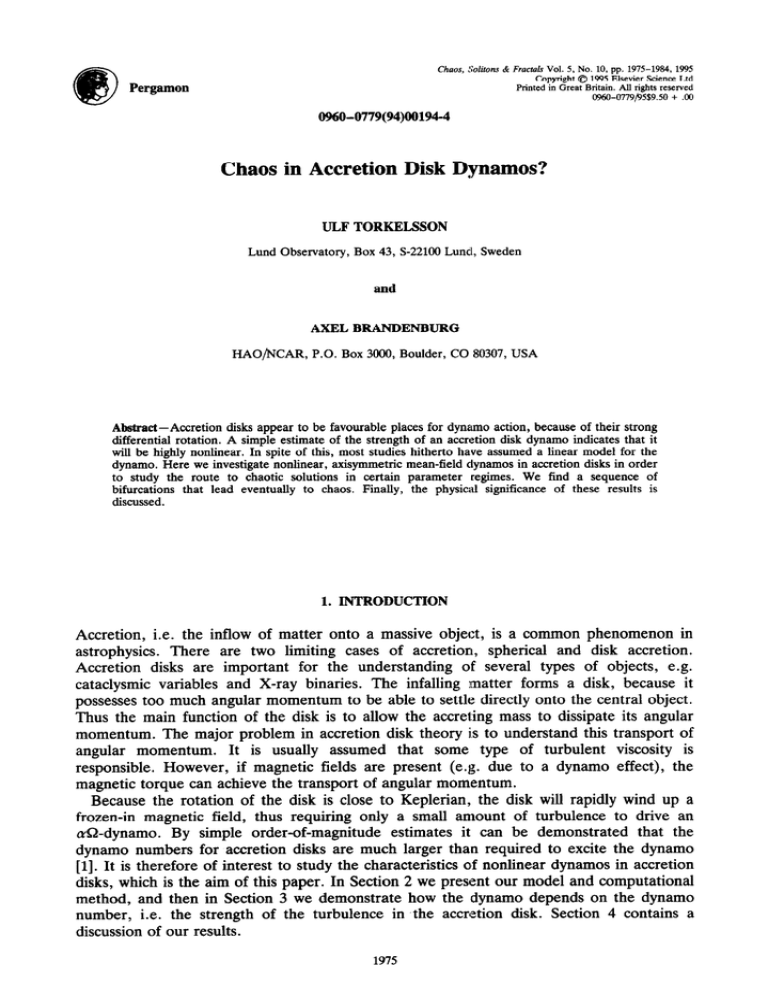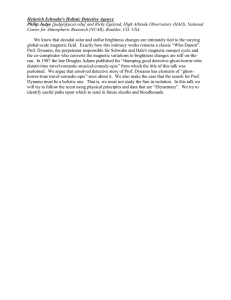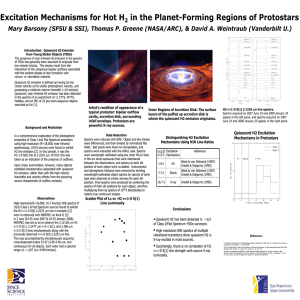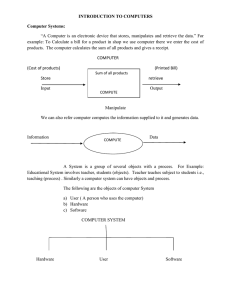
Chaos, :iolitons
& FractnLv Vol. 5, No. 10, pp. 1975-1984, 1995
Copyright
0 1995 Elsevier Science Lfd
Printed in Great Britain. All rights reserved
o!2%0-0779P5S9.50 + .oo
0960-0779(94)00194-4
Chaos in Accretion Disk Dynamos?
ULF TORKELSSON
Lund Observatory, Box 43, S-22100Lund, Sweden
AXEL BRANDENBURG
HAO/NCAR,
P.O. Box 3000, Boulder, CO 80307, USA
Abstract-Accretion disks appear to be favourable places for dynamo action, because of their strong
differential rotation. A simple estimate of the strength of an accretion disk dynamo indicates that it
will be highly nonlinear. In spite of this, most studies hitherto have assumed a linear model for the
dynamo. Here we investigate nonlinear, axisymmetric mean-field dynamos in accretion disks in order
to study the route to chaotic solutions in certain parameter regimes. We find a sequence of
bifurcations that lead eventually to chaos. Finally, the physical significance of these results is
discussed.
1. INTRODUCTION
Accretion, i.e. the inflow of matter onto a massive object, is a common phenomenon in
astrophysics. There are two limiting cases of accretion, spherical and disk accretion.
Accretion disks are important for the understanding of several types of objects, e.g.
cataclysmic variables and X-ray binaries. The infalling lmatter forms a disk, because it
possessestoo much angular momentum to be able to settle directly onto the central object.
Thus the main function of the disk is to allow the accreting mass to dissipate its angular
momentum. The major problem in accretion disk theory is to understand this transport of
angular momentum. It is usually assumed that some type of turbulent viscosity is
responsible. However, if magnetic fields are present (e.g. due to a dynamo effect), the
magnetic torque can achieve the transport of angular momentum.
Because the rotation of the disk is close to Keplerian, the disk will rapidly wind up a
frozen-in magnetic field, thus requiring only a small amount of turbulence to drive an
&&dynamo. By simple order-of-magnitude estimates it can be demonstrated that the
dynamo numbers for accretion disks are much larger than required to excite the dynamo
[l]. It is therefore of interest to study the characteristics of nonlinear dynamos in accretion
disks, which is the aim of this paper. In Section 2 we present our model and computational
method, and then in Section 3 we demonstrate how the dynamo depends on the dynamo
number, i.e. the strength of the turbulence in the accretion disk. Section 4 contains a
discussion of our results.
1975
U, TORKELSSON
1976
and A. BRANDENBURG
2. DISK MODEL AND COMPI.JTA’MONAL MElTIiOD
We assume that the evolution of a mean magnetic field B can be described by the
c&-dynamo equations
g=Vx(uxB+crB
at
- rl,,uoJ)v V-B = 0,
(1)
where u is the mean velocity, a describes the generation of the mean magnetic field
through helical (cyclonic) turbulence, rlt is the turbulent magnetic diffusivity, h the
magnetic permeability of free space, and J = V x B/h the mean electric current. Throughout this paper we assume Keplerian rotation in the main part of the disk, and set u = 0
outside the disk.
Equation (1) is solved numerically in spherical polar coordinates (r, 8, Cp), using the
same method as in [l]. The outer radius of the computational grid, R, is the unit of length,
and the inner radius is at rD = 0.05, where a perfect conductor is assumed. On r = R the
solution is matched to a potential field outside. Assuming axisymmetry, a/a+ = 0, we split
equation (1) into two equations for the B, and A$-fields, where A, is the @-component of
the vector potential.
The geometry of the disk is specified in cylind~cal polar coordinates (a, 4, z). The
half-thickness of the disk is z. = 0.2, the inner edge at nro= 0.15, and the disk extends to
r = R. Outside the disk, but still inside the computational sphere, we assume an enhanced
magnetic diffusivity nQUt,relative to the value rldjsk.inside the disk in order to simulate a
surrounding vacuum. We assume that ljldi& is equal to the kinematic viscasity, for which
Shakura and Sunyaev [2] proposed the simple prescription vdi& = ~sscszo, where c, is
the speed of sound, and cuss a dimensionless parameter less than unity. Assuming
hy~ostatic equilibrium in the vertical direction, we have cz = (G~/~)(zo/~)zo
= Q&,rz~
for a thin disk, where s2keplis the Keplerian angular velocity around an object of mass M.
For most of a thin accretion disk we can make the approximation z. a: m [2] giving
rldisk= v&k z nr’12.Nondimensional UnitS are defined by putting ?& = 1 and q&k(l) = 0.1.
The a-effect describes the effect of cyclonic motion on the magnetic field, and it exists in
the presence of both rotation and stratification. Since the Coriolis force changes sign at the
disk plane, the simplest estimate, is ar = Bz (see [3] for an explicit derivation). Furthermore, there is a feedback from the Lorentz force that quenches cywith increasing B. Thus
a simple form for the o-effect is
1
z s-2
(2)
R Q(ao) 1 -k QZP
where a0 is a characteristic value of a, oB is the inverse equipartition field energy density,
and SZ(Q~)is the Keplerian angular velocity at the inner edge of the disk. The sign of a0 is
defined by the relative importance of the stratification of density and turbulent velocity. If
there is only stratification in density, rising elements expand and get distorted by the
Coriolis force in such a way that a0 > 0 (see Fig 9.1 in [4]). However, if for some reason
the gradient in the turbulent intensity is sufficiently strong, the sign of a0 can be reversed.
Thus it is necessary to investigate both positive and negative values of cyo.
For simplicity we set LYE= const. = 1, but see [l] for results with nonunifo~ tya. The
dynamo is described by two dimensionless numbers, Co = sZ(ao)R2/n0U~, and C, =
~oR/%ut 9 and in the limit Co >> C, solely by the product CQC,. Note that we define the
dynamo numbers and the unit of time, [t] = R*/Q,,,~,
in terms of the magnetic diffisivity
outside the disk, which is different from [l].
a! = @o----------¶
Chaos in accretion disk dynamo:s?
1977
3. PROPERTIES OF NONLINEAR SOLUTIONS
In order to investigate the properties of the magnetic field, we solve equation (1) for
Co = 25,000 and different values of C,. In Figs 1 and 2 we plot the energies of saturated
solutions and the frequencies of the oscillatory solutions as a function of C,. We denote
the solutions of even (odd) parity as SO (AO), where ‘0’ stands for axisymmetry. The
calculations have been carried out either in one quadrant Iof the meridional plane, imposing
the parity on the solution, or in two quadrants and not prescribing a priori the parity of the
magnetic field. The size of the grid is 41 x 41 for one quadrant and 41 x 81 for two. For
solutions of mixed parity we use the parameter
E(s) - ,$A)
P=
E(s) + ,@A)’
where EC’) and EcA) are the energies of the symmetric and antisymmetric parts of the
magnetic field, respectively, to characterize the solutions.
3.1. Positive C,
As expected from linear calculations, a steady SO-solution appears for C, > 0.0013, but
more surprisingly it dies away again before an oscillatory AO-solution emerges (Fig. 1). For
0.0063 < C, < 0.015 only the B = 0 solution is stable. Thiis feature is, however, sensitive to
the type of nonlinearity adopted. If the field is limited by the effect of magnetic buoyancy
[l], the field does not vanish in the gap. Another example is the somewhat unphysical
100 - b
60
-
-.__
m so
A0
60 ;
40;
3
20;
00.001
3
m
0.0 LO
0.003
a
0.030
C,
Fig. 1. (a) Energy and (b) angular frequency as a function of C, > 0. A.0 and SOstand for axisymmetric solutions
of negative and positive parity, respectively. The subscript ‘osc’ in (a) denotes oscillatory solutions. Dashed lines
mark unstable solutions. The stars represent the values for a doubly periodic solution at C, = 0.018 oscillating in
both E and P.
U. TORKELSSON and A. BRANDENBURG
1978
0.10
0.01
-C.
Fig. 2. (a) Energy and (b) augular frequency as a function of C, < 0. m denotes a solutiou of mixed parity
oscillating on one or several frequencies in both E and P, and c denotes a solution varying chaotically in both E
and P, however also the solution at the right end of the m-branch is chaotic. The dashed line shows the minimum
energy for the mixed-mode solutions. The stars stand for a doubly periodic solution of even parity at
p 1. The mixed parity solution at C, = -0.063 is
C, = -0,076. All other symbols have the same meaning as in Fif$.
triple-periodic, but the third frequency w = 1.5 has not been included in the plot.
quenching via the total energy, i.e. (YCCl/(1 + E) [5, 61, in which case the energy always
increases linearly with C,, and thus no gap is possibfe.
For larger C, there appears firstly an oscillatory BOO-solution(C, > 0.013), and then also
an oscillatory SO (C, > 0.016) which, however, is initially unstable to perturbations of
opposite parity. (We are able to calculate the unstable solution of pure parity by
constraining the calculations to one quadrant and imposing the parity on the numerical
solution.} This SO-solution becomes stable shortly after the appearance of a doubly periodic
solution oscillating in both E and P with the angular frequencies CI.I= 87.6 and 5.4. At this
point (C, = 0.018) the frequency difference of these two solutions is minimal. Beyond this
point both the SO- and AO-~lutions are stable, and initial seed fields of mixed parity will
evolve to either one of the two solutions. There is a watershed between two possibilities: at
C, = 0.02, for example, solutions with P > -0.118 evolve to SO, and those with
P -=c-0.118 to AO.
3.2.
Negative C,
The situation is more complicated for C, < 0 (Fig. 2). The first nontrivial solution is
steady and has P = -1 (]C,] >0.015). Th is solution was not found in the corresponding
linear calculations [l]. When we decreased ]C,] to 0.014, the magnetic field decayed
towards zero, but if IC,] was put equal to 0.015 before the magnetic field strength had
gone down by too much, we found a new steady solution at a smaller magnetic energy,
which is the lower branch of the curve. However, for ]C,l > 0.016 this solution becomes
unstable, and the magnetic field evolves to the stat’e corresponding to the upper branch of
the curve.
Unfortunately, it is impossible to trace unstable solutions of the same parity using a
time-stepping method, but we expect that this solution originates from a subcritical
Chaos in
accretiondiskdynamos?
1979
bifurcation of the trivial solution. It is interesting to note that for disks with slightly
different geometrical properties (smaller .zo or larger zrr,,), this solution emerges via an
ordinary supercritical bifurcation [ 11.
At C, = -0.020 there are supercritical bifurcations to oscillatory SO- and AO-solutions.
The two solutions have similar energies and frequencies, but the SO-solution is unstable.
Later the AO-solution becomes oscillatory in both E and P, and after some time also
doubly periodic (Figs 3, 4). The phase portrait and Poincare map (Fig. 4) for C, = -0.039
indicate that the trajectory of this solution lies on a T* torus. From the power spectrum it is
also evident that there are two frequencies with most of the power being at the higher
frequency. The amplitude of the oscillations in E reaches a minimum close to C, =
-0.036, whereas the amplitude of P continuously increases. At C, = -0.063 a third
(smaller) frequency, appears at w = 1.5 (Fig. 5), suggesting that the solution evolves on a
T3 torus. Now the strongest power is at the intermediate frequency. The phase portrait and
the Poincare map of the solution shows rather regular behaviour, suggesting that the
solution is perhaps not a T3 torus, but a more complicated T* torus (Fig. 6).
Later there first appears a chaotic solution for a narrow interval around -0.069, and
then at C, = -0.076 the solution is again doubly periodic with the angular frequencies
o = 70.4 and 6.6, but it has changed character to be of pure quadrupole parity and is only
oscillating in the magnetic energy. Increasing the dynamo number to C, = -0.084 leads
finally to a chaotic solution, with variations both in E and P (Fig. 7). The phase portrait
and the Poincare map of this solution is plotted in Fig. 8. Note that the previously sharp
peaks in the power spectrum have broadened to two less well-defined humps.
-1.24F
.
.
.
8.0
8.5
9.0
9.5
10.0
8.0
8.5
9.0
9.5
10.0
0
20
40
60
$
80
100
0
Fig. 3. The
evolutionsof
E (a) and P (b) for a doubly periodic solutio:n with C, = -0.039.
of E is displayed in (c). Note the two peaks at w = 7 and w = 71.
The power spectrum
1980
U. TORKELSSON and A. BRfiNDENBURG
a
b
0.020
o.E120
1
0.010
0.1110
XT
0.000
0
0.000
-0.010
-0.010
-0.020
D
-0.020
~
I
-4x10+
0
-4x10-6
4x 10-6
ai
Fig. 4. (a) The phase portrait of the solution for C, = -0.039 (see Fig. 3) projected onto the A+ - Be-plane of a
point at (m, z) = (0.52, -0.04) in the grid. (b) The Poincare map of this solution. We plot the points where the
B+-field at (0.52, 0.04) goes ihrough zero.
-0.6
4
-0.8
zJ -1.0
-1.2
0
2
4
6
0
10
60
80
100
t
0
20
40
0
Fig. 5. The variations in E (a) and P (b) for a t~piy-~~odic dynamo solution with C, = -0.063. The power
spectrum of the oscillations in E are displayed in (c). Note the occurrence of three distinct frequencies at
wr = 1.5, w, = 6, and w3 = 68. (The peak at about 7.5 results from the superpositition of wr and y.)
Chaos in accretion disk dynamos?
t
-2.5x1o-a
-2.5x10--"
2.5x1o-5
0
=1
1981
0
2.5x10-"
=1
Fig. 6. (a) The phase portrait of the solution for C, = -0.063 projected onto the A9 - Be-plane of a point at
(TV,z) = (0.52, -0.04) in the grid. (b) The Poincare map of this solution. We plot the points where the Be-field in
(0.52,0.04) goes through zero.
0
5
10
15
20
25
30
0
5
10
15
20
25
30
1.0
0.5
a
0.0
.0.5
.l.O
t
0.5
b 0.0
# -0.5
& -1.0
,M -1.5
z,2*g
0
20
60
40
60
100
0
Fig. 7. The variations in E (a) and P (b) for an irregular dynamo solution with IC,I = 0.084. The power spectrum
of the oscillations in E are displayed in (c).
1982
U. TORKELSSON and A. BRANDENBURG
I..o
0.5
7
.
.
.:
.. . . . .
.,.. .
0.0
~. ‘&&.
:. .c .
),.’ . . ”
&$$~~
‘..
. ... .
..
“.
I
-0.5
- 1.c
-5x1o-s
0
0
al
al
5x10+
Fig. 8. (a) The phase portrait of the chaotic solution projected onto the A+ - Be-plane of a point at
(m, z) = (0.52, -0.04) in the grid. (b) The Poincare map of the same solution. We plot the points where the
B,-field in (0.52,0.04) goes through zero.
To characterize the chaotic nature of a solution, it is of interest to calculate its Lyapunov
exponents. To determine the largest Lyapunov exponent, Izl, it is sufficient to add a small
disturbance to the solution and evolve both solutions for some time. We added a relative
disturbance of 10m6to the A,-field and determined the rate of divergence for the B,- and
A#-fields separately (Fig. 9). For C, = -0.069 and -0.084, we found in this way AI = +1.3
and +2.5, respectively. A positive value of A, demonstrates the chaotic nature of the
solution. These values can be compared with the linear growth rates of the magnetic field,
which are 92 and 116, respectively. Thus the Lyapunov exponents are of the order of the
inverse of the magnetic diffusion timescale, whereas the linear growth rates are much
larger.
Ob...
20
21
22
213
24
25
V
Fig. 9. The first cumulative Lyapunov exponent for C, = -0.084. The solid line is determined from the
A,+-component, and the dashed line from the Be-component.
Chaos in accretion disk dynamos?
1983
In order to estimate the dimension of the attractor, it would be of interest to determine
the next largest Lyapunov exponents. We tried to estimate them both using a GramSchmidt o~hono~a~zation of a bunch of nearby trajectories [7], and from a time series of
the magnetic energy for a solution that was evolved for a long time [g]. So far, however,
none of these techniques yielded reliable results in our case.
4. DIsCUS!3ION
It is evident that results from linear calculations are misleading and insufficient for
determining the magnetic field geometry in astrophysical bodies. For example, Moss and
Tuominen [9] simulated nonlinear dynamo action in galactic disks and found the possibility
of long-lived mixed-parity states. Complicated bifurcation diagrams including stable mixedparity solutions have been found in galactic disk-halo systems [lo], and Brooke and Moss
[ll] studied the transition to chaos in a dynamo with torus geomet~ and Keplerian
rotation.
There are similarities between the bifurcation sequence found in this paper and other
nonlinear calculations. For a one-dimensional solar dynamo model, Jennings [12] found a
steady SO-solution whose amplitude vanished for sufficiently large C, while a new
oscillatory AO-solution emerged. Similar behaviour was found by Brandenburg et al. [lo]
for a galactic dynamo. There is also a qualitative agreement in the form of the
doubly-periodic oscillations of P (Fig. 2 in [lo]).
We should recall that an accretion disk has Keplerian rotation, leading to a stronger
shear than in a galactic disk. Brooke and Moss [ll] adopted such a Keplerian rotation law,
but instead of a disk they employed a torus geometry. An interesting difference is that for
SO-solutions with positive C,, they only find steady solutions up to 30 times the critical
value. This is a much larger interval than that in which we find a steady SO-solution.
Nevertheless, they do find a gap with no dynamo excitation, but only in the linear theory.
For negative C, they find an oscillatory AO-solution, which later bifurcates to a doublyperiodic solution. This is in agreement with our result. When ]C,] increases further, the
solution eventually begins to vary irregularly, however they do not find the second T2
torus, as we do.
The route to chaos, T* (-+ T3>+ chaos-+ TZ+ chaos, suggested from our model, is
similar to the bifurcation sequence found by Feudel et al. [13] for a rather different (solar
dynamo) model. However, they do not find the intermediate chaotic state, which anyhow
occurs only in a very narrow interval.
The disk model in our simulations is much thicker than real accretion disks, thus we
cannot draw any qu~titative conclusions regarding the behaviour of the magnetic fields of
real accretion disks. However, it is worthwhile to draw a few qualitative conclusions. It is
likely that C, is positive in a real accretion disk, and it is therefore not clear whether our
results of chaotically varying magnetic fields will occur in nature. On the other hand we
find that for C, > 0 the field is not always a steady quadrupole field as expected from
linear theory. This is of great importance for theories of magnetohydrodyn~ic
jet
acceleration from accretion disks, because such mechanisms are usually more efficient for
dipolar fields (e.g. [14]). An oscillatory magnetic field may also give rise to cyclic variations
in an accretion disk, similar to the activity cycle of the Sun. Such variations may be
observable through changes of the strength of emission lines (cf. [15]). Turning the whole
argument around, we may gain a better understanding of the turbulent properties of
accretion disks by observing magnetic fields in the disk. If no magnetic field exists, or if
there is only a small-scale irregular magnetic field, we may obtain useful constraints on the
turbulent properties of the disk.
U. TORKELSSON and A. BRANDENBURG
1984
In conclusion, we have demonstrated that nonlinear effects may lead to the appearance
and dominance of disk dynamo solutions other than the most easily excited ones. This is in
particular the case for the steady SO-solution, which appears for the smallest dynamo
number, but later it disappears again before any other mode has been excited. This gap of
dynamo activity for certain dynamo numbers may be important for the properties of
magnetic fields in accretion disks. It is also of interest for dynamo theory that we find both
regularly oscillating and chaotically varying solutions of mixed parity, for certain parts of
the parameter space.
Acknowledgements-The
National Center for Atmospheric Research is sponsored by the National Science
Foundation. The computations presented in this paper have been carried out mainly on the Cray X-MP 4/16 at the
National Supercomputer Centre, Linkiiping, Sweden. We wish to thank the WE-Heraeus-Stiftung for financial
support making the participation at this conference possible. We are also grateful to Ulrich Parlitz for determining
Lyapunov exponents from a time series.
REFERENCES
1. U. Torkelsson and A. Brandenburg, Turbulent accretion disk dynamos, Astron. Astrophys. 283, 677 (1994).
2. N. I. Shakura and R. A. Sunyaev, Black holes in binary systems. Observational appearance, Astron.
Astrophys. 24, 337 (1973).
3. G. Riidiger, The alpha-effect in galaxies is highly anisotropic, Geophys. Astrophys. Fluid Dyn. 50, 53 (1990).
4. F. Krause and K.-H. Rgdler, Mean-field Magnetohydrodynanrics
and Dynamo Theory. Pergamon, Oxford
(1980).
5. F. Krause and R. Meinel, Stability of simple nonlinear &dynamos, Geophys. Astrophys. Fluid Dyn. 43, 95
(1988).
6. A. Brandenburg, F. Krause, R. Meinel, D. Moss and I. Tuominen, The stability of nonlinear dynamos and
the limited role of kinematic growth rates, Astron. Astrophys. 213, 411 (1989).
7. A. Wolf, J. B. Swift, L. Swinney and J. A. Vastano, Determining Lyapunov exponents from a time series,
Physica D, 16, 285 (1985).
8. U. Parlitz, Identification of true and spurious Lyapunov exponents from time series, J. Bifurcation Chaos 2,
155 (1992).
9. D. Moss and I. Tuominen, Nonlinear galactic dynamos, Geophys. Astrophys. Fluid Dyn. 50, 113 (1990).
10. A. Brandenburg, K. J. Donner, D. Moss, A. M. Shukurov, I). D. Sokoloff and I. Tuominen, Dynamos in
discs and halos of galaxies, Astron. Astrophys. 259, 453 (1992).
11. J. M. Brooke and D. Moss, Nonlinear dynamos in torus geometry: Transition to chaos, Month. Not. Roy.
Astron. Sot. 266, 733 (1994).
12. R. L. Jennings, Symmetry breaking in a nonlinear cYw-dynamo, Geophys. Astrophys. Fluid Dyn. 57, 147
(1991).
13. U. Feudel, W. Jansen and J. Kurths, Tori and chaos in a nonlinear dynamo model for solar activity,
J. Bifurcation
Chaos 3, 131 (1993).
14. J. C. L. Wang, M. E. Sulkanen and R. V. E. Lovelace, Self-collimated magnetic jets from magnetized
accretion disks: The even symmetry case, Astrophys. J. 355, 38 (1990).
15. K. Horne and S. H. Saar. Rotation and emission lines in stars and accretion disks, AstroDhvs. J. 374. L55

![Paul Charbonneau [], Département de Physique, Université de Montréal, Canada](http://s2.studylib.net/store/data/013086474_1-07f8fa2ff6ef903368eff7b0f14ea38f-300x300.png)



